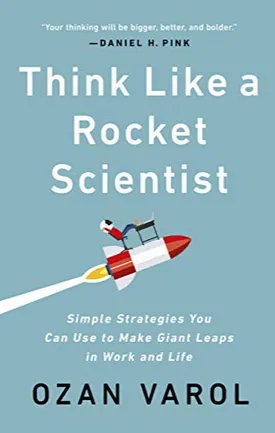Think Like a Rocket Scientist: Simple Strategies You Can Use to Make Giant Leaps in Work and Life by Ozan Varol
Welcome to our website featuring book summaries on “Think Like a Rocket Scientist: Simple Strategies You Can Use to Make Giant Leaps in Work and Life” by Ozan Varol. This book is an inspirational way to approach and look at various aspects of our life and career.
“Think Like a Rocket Scientist” is a book that doesn’t just focus on how to become a rocket scientist, but how to use the same ideas and strategies they use to achieve success in other aspects of life. The book encourages readers to think in ways often overlooked in traditional problem-solving methods, and to strive for big, bold changes.
At the heart of the book is the idea that achieving your potential is about thinking outside the box. Varol equips readers with a framework and outlined strategies for creative problem-solving that rocket scientists use. The book reveals how to break down a problem into understandable and manageable steps, how to think intuitively, how to use a “reverse engineering” approach, how to find new ideas and how to anticipate and plan for the unexpected. These and other tips enable readers to “make giant leaps” in their work and life.
The author shares his experiences and lessons that he has gained from his own time as a rocket scientist. He discusses how he was able to take complicated problems and break them down into their basic components by looking at them from different angles. He also emphasizes developing abstract thinking and deep learning, which are core skills for rocket scientists. Beyond that, he introduces the idea of creative problem-solving and analytical problem-solving, which he believes are vital for successful problem solving.
In addition to the skills and lesson that rocket scientists possess, the author emphasizes the importance of “stretch goals”. He challenges readers to aim higher than they thought they could, to think bigger than they’ve ever thought, and to create their own stretch goals. By pushing oneself outside of one’s comfort zone, readers can find inspiration and creativity. This is often necessary in order to make giant leaps in work and life.
To round out the book, Varol provides several case studies. These showcase real-world examples of how the same principles applied in the book can be implemented in practical situations. From data-driven approaches to tactics for influencing others, these stories demonstrate the book’s content in action.
In summary, “Think Like a Rocket Scientist” offers an effective and creative approach to problem-solving. It provides readers with a framework and outlined strategies for analytical and creative problem-solving. It encourages readers to think outside the box and to set stretch goals. It also provides case studies to help readers apply the principles to their own work and life. The book is an inspirational motivator to make big changes and pursue big goals.

